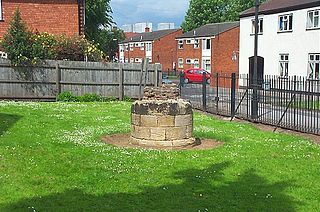Related Research Articles

Daventry is a market town and civil parish in the West Northamptonshire unitary authority area of Northamptonshire, England, close to the border with Warwickshire. At the 2021 Census, Daventry had a population of 28,123.

Everdon is a village in West Northamptonshire in England, some 3 miles (4.8 km) south of Daventry. The population of the civil parish at the 2011 census was 356.
The history of Northamptonshire spans the same period as English history.

Thorpe Mandeville is a village and civil parish in West Northamptonshire, England about 6 miles (10 km) northeast of Banbury in neighbouring Oxfordshire. The hamlet of Lower Thorpe is just north of the village.

Sulgrave is a village and civil parish in West Northamptonshire, England, about 5 miles (8 km) north of Brackley. The village is just south of a stream that rises in the parish and flows east to join the River Tove, a tributary of the Great Ouse.

Cluny Abbey is a former Benedictine monastery in Cluny, Saône-et-Loire, France. It was dedicated to Saints Peter and Paul.

Delapré Abbey is a neo-classical mansion in Northampton, England.

South Northamptonshire is a constituency represented in the House of Commons of the UK Parliament since 2024 by Sarah Bool. As with all constituencies, the constituency elects one Member of Parliament (MP) by the first past the post system of election at least every five years.

Thetford Priory is a Cluniac monastic house in Thetford, Norfolk, England. Founded in 1103 by Roger Bigod of Norfolk, Thetford was one of the most important monasteries of East Anglia.

Lenton Priory was a Cluniac monastic house in Nottinghamshire, founded by William Peverel circa 1102-8. The priory was granted a large endowment of property in Nottinghamshire and Derbyshire by its founder, which became the cause of violent disagreement following its seizure by the crown and its reassignment to Lichfield Cathedral. The priory was home mostly to French monks until the late 14th century when the priory was freed from the control of its foreign mother-house. From the 13th-century the priory struggled financially and was noted for "its poverty and indebtedness". The priory was dissolved as part of King Henry VIII's Dissolution of the Monasteries.

Lewes Priory is a part-demolished medieval Cluniac priory in Lewes, East Sussex in the United Kingdom. The ruins have been designated a Grade I listed building.

In the Middle Ages, from the 11th century, the Cluniac order established a number of religious houses in England, Wales, and Scotland.

Pontefract Priory was a Cluniac monastery dedicated to St. John the Evangelist, founded about 1090 by Robert de Lacy, 2nd Baron of Pontefract, and located in Yorkshire, England. It existed until the dissolution of the monasteries. The Church and buildings have been completely destroyed, but the site is still indicated by the name of Monk-hill.

The Cluniac Priory of Wangford was a small religious house in Wangford in the English county of Suffolk. It was founded before 1159 as a dependency of Thetford Priory. In 1376, it was naturalised before being dissolved in 1540.

Montacute Priory was a Cluniac priory of the Benedictine order in Montacute, Somerset, England.
The Priory of St Mary Magdalene was a Cluniac priory in Monkton Farleigh, Wiltshire, England, in the 12th to 16th centuries.
St Andrew's Priory was a Cluniac house in Northampton, England.
Francis Lockier, BD was the first dean of Peterborough.

The Church of Holy Cross is the grade I listed parish church of Daventry in Northamptonshire, England. Holy Cross is the only 18th-century town church in Northamptonshire.
